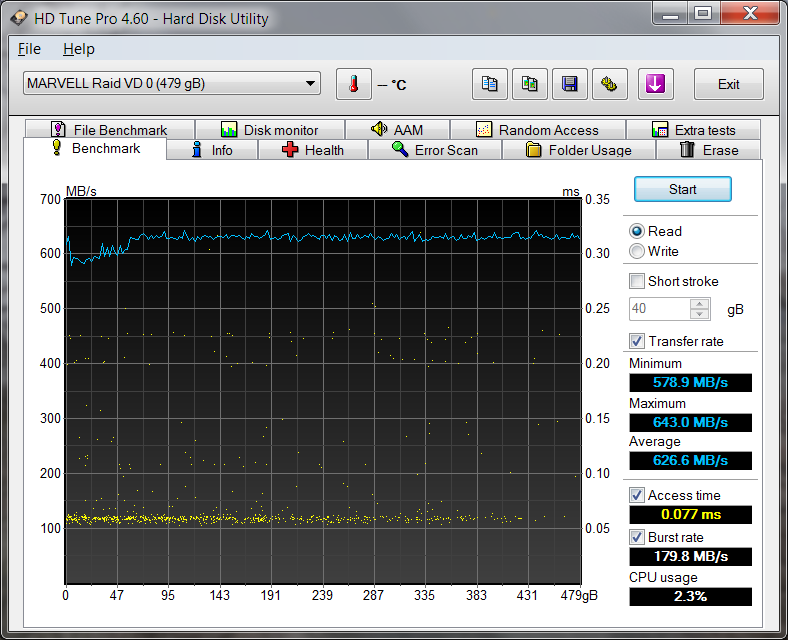HDTUNE PRO VER. 4.6 “ BENCHMARK
HDTune Pro is a great software program that lets us have a look at all aspects of testing through several separate tests:
BENCHMARK
 We don’t use HDTune Pro much anymore as, for the most part, it simply confirms what we have been seeing in other benchmarks… in most cases. In this scenario, we thought it was an excellent representation of performance where transfer speeds in excess of 600-700MB/s can be seen in the two bottom charts.
We don’t use HDTune Pro much anymore as, for the most part, it simply confirms what we have been seeing in other benchmarks… in most cases. In this scenario, we thought it was an excellent representation of performance where transfer speeds in excess of 600-700MB/s can be seen in the two bottom charts.
 The SSD Review The Worlds Dedicated SSD Education and Review Resource |
The SSD Review The Worlds Dedicated SSD Education and Review Resource | 

Is it bootable?
Yes it is bootable.
can i use trim comand? does it have a garbage collector? after intensive use of the drive will it perform slower?
No TRIM would not work with this RAID 0 configuration, however, Garbage Collection would do its job with the SandForce drives. Unfortunately, the product doesn’t remain with us for a long period so any degradation cannot be measured through continuance use and analysis.
no, yes, yes
Does the drive maintain the same performance figures in its smaller configuration (120GB)?
It seems wrong to call this card a PCIe SSD card as such since it is really a Raid/HBA card which happens to accept mPCIe SSD’s on the board itself. And just why wasn’t this card manufactured with the ability to install 4 mPCIe SSD’s from the get go?
The Accelsior uses the Marvell 88SE9230 which only supports PCIe 2.0 x2 which only allows up 1000 MB/s. You would need to use a chip with 4 lanes (such as the Marvell 88SE9445) to get the full performance out of 4 SSD’s. Maybe that chip doesn’t have the boot ability that OWC advertises.
Would you happen to know/offer any card or adaptor to connect an SSD like this (https://www.toshiba.com/taec/news/press_releases/2010/memy_10_604.jsp) and retrieve the data? It is the SSD from an Asus UX31 and I think the connection is similar to the ones of the SSDs in the newer versions of the Macbook Air.
No, I don’t know of any adapters to assist other than installing this SSD in a system that utilizes it such as the Zenbook. Beware as they may look the same but the ‘blade’ type SSD is of a different configuration for Mac and PC. They aren’t interchangeable.
Thank you kindly for your reply. I actually might have found a solution, see https://www.digitalintelligence.com/products/blade_type_adapter.
But since they’re of a different configuration this might not work you say? I’d just like to know my changes before buying 😉 Thanks heaps for your help!
Please run CrystalDewWorld’s DiskMark with a larger test size. At 1000MB, the filesystem cache can skew results upwards. For example, running DiskMark w/1000MB on my system shows read/write operations around 480MB/s. Cranking up the test size to 4000MB returns a more realistic 290MB/s — appropriate for a SATA II SSD drive.
The results are consistent with all others and, unfortunately, the drive is no longer in our possession. Sorry.
I’m a bit puzzled as to exactly a PCIe SSD card does for a computer. I have an older Intel MAC Pro tower used mostly for audio recording and am trying to extract a bit more performance from the box during in-the-box multi-track audio recording. Does this device essentially only increase the read/write performance between the computer and external drives or are there other benefits? TIA
External drives? PCIe allows for much higher performance as the SATA 3 bottleneck does not exist between the card and the board as it does between the SSD and SATA 3 interface.
spotted something that needs correction in your review- SandForce SF-2281 is a SATA controller not PCIe, and the Marvell RAID controller is also a SATA part. Not sure where you got the idea that the SSDs in this review were PCIe, but they are not.
The review is correct and it is not stated that the SF-2281 is a PCIE controller. This package is a PCIE product, in that, it is connect d via this route. Thanks anyway.
Thanks for your quick reply- however your review states
‘There are three detachable components which are the PCIe itself and two upgradable ‘blade’ mPCIe SSDs that can be switched off for higher capacity.’
You have clearly referred to the SSDs as mPCIe which is not correct. Thanks anyway.
I am curious what validation you might have to prove this. Considering both the RAID controller and SSD controller are both PCIE compliant, your opinion should be validated in some way. Simply because the connector of the blade SSDs is custom, does not mean the term still cannot be used for best explanation to the reader, similar to the way one compares an Apple SSD to that of the M2.
The use of mPCIe was used as the best explanation at the time for the custom connector. While you are correct that the controller is SATA on each blade SSD, this custom solution is a PCIE design. Thanks again.